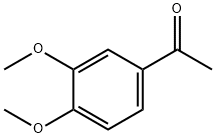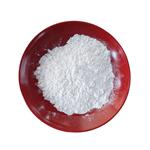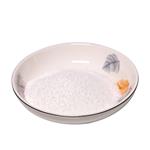Synthesis

To a stirred mixture of 3´,4´-dihydroxyacetophenone (100 mg, 0.66 mmol) and anhydrous K2CO3 (5 g, 36 mmol) in dry acetone (10 mL) was added MeI (1 mL, 16 mmol). The mixture was heated at reflflux for 45 min, cooled to room temperature, fifiltered, and evaporated under reduced pressure. The residue was dissolved in CH2Cl2, washed with 2 portions of water, dried over anhydrous Na2SO4, and evaporated under reduced pressure. The product was purifified by flflash chromatography (silica, hexane/EtOAc 4:1, v/v). Removal of the solvent gave a 93% yield of the product, 3´,4´-dimethoxyacetophenone (110 mg, 0.61 mmol). Reference: Khatib, S.; Nerya, O.; Musa, R.; Shmuel, M.; Tamir, S.; Vaya, J. Bioorg. Med. Chem. 2005, 13, 433−441.
Chemical Properties
yellow to beige crystalline powder
Uses
3',4'-Dimethoxyacetophenone is used as Catalytic agent; Petrochemical additive. It is also used in agrochemical, pharmaceutical and dyestuff field.
Preparation
Obtained by reaction of dimethyl sulfate with acetoguaiacone in the presence of sodium hydroxide in ethanol, first at 50°, then at reflux for 1 h (78%).
Definition
ChEBI: A member of the class of acetophenones that is acetophenone substituted by methoxy groups at positions 3' and 4' respectively.
References
[1] G. Hawkes. “An unusual anodic methoxylation: 3,4-dimethoxyacetophenone.” Tetrahedron Letters 33 1 (1992): 8133–8136.
[2] P. Kuzmi?, M. Soucek. “Substituent effects in aromatic photochemistry. UV irradiation of 3,4-dimethoxybenzonitrile and 3,4-dimethoxyacetophenone in the presence of inorganic anions.” Collection of Czechoslovak Chemical Communications 52 1 (1987): 980–988.
[3] Virginia Vetere . “Study of the racemic and enantioselective hydrogenation of acetophenone and 3,4-dimethoxyacetophenone using platinum-based organotin catalysts.” Catalysis Today 107 (2005): Pages 266-272.


 To a stirred mixture of 3´,4´-dihydroxyacetophenone (100 mg, 0.66 mmol) and anhydrous K2CO3 (5 g, 36 mmol) in dry acetone (10 mL) was added MeI (1 mL, 16 mmol). The mixture was heated at reflflux for 45 min, cooled to room temperature, fifiltered, and evaporated under reduced pressure. The residue was dissolved in CH2Cl2, washed with 2 portions of water, dried over anhydrous Na2SO4, and evaporated under reduced pressure. The product was purifified by flflash chromatography (silica, hexane/EtOAc 4:1, v/v). Removal of the solvent gave a 93% yield of the product, 3´,4´-dimethoxyacetophenone (110 mg, 0.61 mmol). Reference: Khatib, S.; Nerya, O.; Musa, R.; Shmuel, M.; Tamir, S.; Vaya, J. Bioorg. Med. Chem. 2005, 13, 433−441.
To a stirred mixture of 3´,4´-dihydroxyacetophenone (100 mg, 0.66 mmol) and anhydrous K2CO3 (5 g, 36 mmol) in dry acetone (10 mL) was added MeI (1 mL, 16 mmol). The mixture was heated at reflflux for 45 min, cooled to room temperature, fifiltered, and evaporated under reduced pressure. The residue was dissolved in CH2Cl2, washed with 2 portions of water, dried over anhydrous Na2SO4, and evaporated under reduced pressure. The product was purifified by flflash chromatography (silica, hexane/EtOAc 4:1, v/v). Removal of the solvent gave a 93% yield of the product, 3´,4´-dimethoxyacetophenone (110 mg, 0.61 mmol). Reference: Khatib, S.; Nerya, O.; Musa, R.; Shmuel, M.; Tamir, S.; Vaya, J. Bioorg. Med. Chem. 2005, 13, 433−441.


